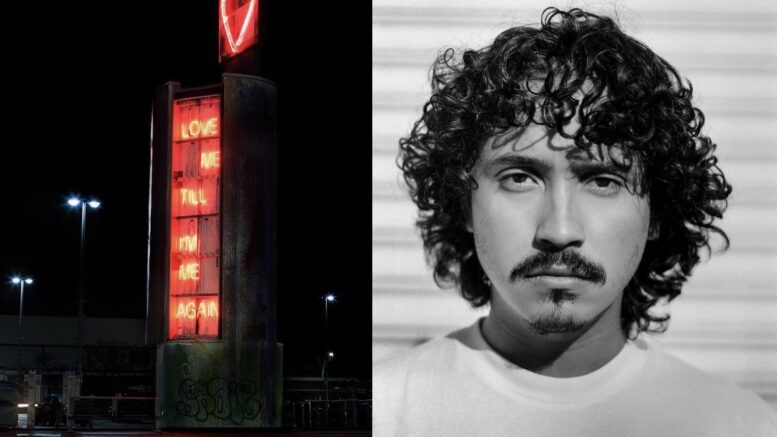Angel Fonseca, 22, spends hours in his home office each day editing his photographs until they are perfect. What sets him apart from other artists is his attention to detail, the relationships he forms with his clients, and his passion for inspiring others through his work.
Fonseca is a Toronto-based freelance film photographer currently enrolled in the arts photography program at Toronto Metropolitan University (TMU). He uses his art form to express his feelings, connect with others and cope with mental health struggles he’s experienced.
His goal to inspire others appears to be working. Fonseca currently has 90,500 followers on Instagram and 141,300 followers on TikTok. People have told him his artwork provides them with a sense of connection and helps them heal from their own personal struggles, whether that’s battling feelings of anxiety and depression, feeling alone, isolated, or lost, or going through a bad breakup, Fonseca’s work captures real and raw emotions that anyone can interpret or connect to.
“I suck at expressing my feelings verbally, so I’ve learned to channel my energy through photography to create artworks that I currently experience and that others can connect with,” he said in an interview.
Fonseca said that he hopes that the people who engage with his artwork are able to connect with it in any way that resonates with them. As much as photography is an escape for him, he wants to use his skills to help inspire others to process the feelings they may experience through his art.
Watch Angel Fonseca explain his photography:
Engaging in the arts as a form of therapy to cope with mental illnesses is a growing field of study. Recent research on neuroaesthetics, which measures the brain’s response to creating art, has shown it is effective.
Severity of mental health issues in Canada
Mental illness, or mental health disorders, can cover a wide variety of mental health conditions that change or affect a person’s mood, behaviour, and thinking habits. Although every person’s experience of mental illness differs, one thing is certain: The mental health crisis in Canada is real, growing quickly, and needs to be addressed.
According to the Centre for Addiction and Mental Health, one in five Canadians experience mental illness each year. What’s more, mental illness can cut up to 20 years from a person’s life expectancy.
In 2021, a study showed that more than 50 per cent of Canadians who experienced mental illnesses did not seek any help, whether through therapy, medication, or other outlets. There are many factors to why a person may not seek help, such as cost, fear of being judged, or long wait lists.
Fonseca said that a lot of his earlier work is very sad and reflects themes of heartbreak, isolation, and loneliness because it portrayed what he was going through at the time. When he was struggling with his own mental health, photography was an outlet for him to express what was going on in his mind without having to outwardly speak about it.
Some of these works include Lost in my own thoughts, Solo date series, and Love me till I’m me again. Although an artist’s work may reflect what they are going through mentally, the way people interpret their art pieces can vary greatly based on their mental state at the time, as their personal experiences and emotions can all influence their perception and understanding of the artwork.
“If you can express yourself through an art, just really maximize that because others can heal from it as well,” said Fonseca.

Fonseca expresses how he feels through his photography. (Photo courtesy Angel Fonseca)
Engaging in the arts
Suze G. Berkhout, assistant professor in the Department of Psychiatry at the University of Toronto and a clinical-investigator at the University Health Network Centre for Mental Health, specializes in mental health and managing stress and anxiety.
“When it is hard to find the words to explain or express something, engaging in a creative practice to do that expression can be very therapeutic,” she said.
Berkhout explained that there are multiple aspects of engagement in the arts that are beneficial for a person’s mental well-being.
“Artistic works can help people process or understand their own experience … which can help people feel less isolated and more understood by opening new ways of experiencing a distressing situation,” she said.
Berkhout explained that engaging in the arts is not only beneficial to the ones creating art, but can be beneficial to those encountering it too because it connects people through experiences.
“The benefits to engagement in creative practices are many, and when people are managing stress, anxiety, and depression, some of this benefit is that arts practices connect us to communities and stories and understandings outside of ourselves.”
How art promotes mental well-being
A new field of research called neuroaesthetics studies the brain’s response to creating art. Anjan Chatterjee, a neurology professor at the Perelman School of Medicine in Pennsylvania, wrote that the term neuroaesthetics describes how the brain processes beauty and/or art to understand the perception, production, and response to art and creative expression in our bodies.
A study on neuroaesthetics conducted by the University of Calgary in 2020 demonstrated that the creation of art can reduce cortisol levels and promote well-being, mindfulness, and flow in the body.
“Neuroaesthetics uses brain imaging, brain wave technology, and biofeedback to gather scientific evidence of how we respond to the arts [and shows] that the arts engage the mind in novel ways, tap into our emotions in healthy ways, and make us feel good,” Brittany Harker Martin, an assistant professor at the University of Calgary, explained in a piece for The Conversation.
What is cortisol?
According to Health Direct, a health information service that provides expert guidance, cortisol is a steroid hormone located on each of your kidneys and marks the stress levels in your body. There are many functions of this hormone, such as providing a response to stressful or dangerous situations and the “fight or flight” reaction, which is why it is crucial to produce a balanced amount of cortisol in the bloodstream.
When someone is stressed, they have increased levels of cortisol in their bodies, meaning their bodies are constantly producing heightened levels of this stress hormone.
This can lead to severe long-term effects to one’s physical and mental health, such as an increased risk of heart disease, lung issues, obesity, anxiety, depression, and more, according to Health Line, a news site to help individuals make informed decisions about their health and well-being.
A 2016 study of 39 people published in the journal Art Therapy found that making art for 45 minutes lowered 75 per cent of the participants’ cortisol levels.
These findings are a significant step forward for people who struggle with mental illnesses because creating art has proven to help people destress and process their emotions.
Well-being, mindfulness, and flow
According to another study on the benefits of art therapy, creating art releases dopamine into the body, which is a chemical neurotransmitter that sends feelings of pleasure or happiness to the brain.
“Art therapy can be used as a complement to traditional mental health treatment,” Mary Ann Cohen, of Resources to Recover, wrote in a study of art therapy in 2018. “The aim is to manage behaviours, process feelings, reduce stress and anxiety, and increase self-esteem.”
Read more from the Toronto Observer:
- When students feel stressed amid exams, these therapists reach out a paw
- Shift to post-secondary life is massive and under-discussed, therapist and students say
- While we wait: Canadians in greater need of accessible mental health services
Mental health advocate Bradley Braich, co-founder of Bigger Than Basketball, a nonprofit that donates all funds to the Canadian Mental Health Association, also appreciates the connection between art and mental health.
“As someone whose undergraduate degree focuses on effective therapies for mental illness, I would of course stand with this newer research (of art therapy),” he said. “I can imagine there are several benefits related to neurocognition from enacting the use of art.”
In fact, in his darkest times, Braich said he turned to a pencil and a piece of paper to express himself. “Although I didn’t realize it at the time, the emphasis of what I was drawing or writing always surrounded my inner struggles.”
Pursuing photography put Fonseca in the right direction to help get him where he is today. His mental health has improved greatly and he has gained a huge amount of supporters who are inspired by his work.
Fonseca uses photography as an outlet to express and understand his emotions, while creating art for other people to heal through. What was once a creative outlet for him is now something so much more: Not only has his artwork become extremely successful and been an outlet for him to heal through, it also heals and inspires other people who are struggling with their mental health to engage and learn the power of expression through art when battling mental illnesses.
“Without photography, I wouldn’t have done therapy, I wouldn’t have done self help courses, so it’s been really beneficial towards my mental well-being,” he said.

